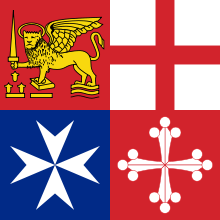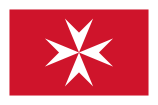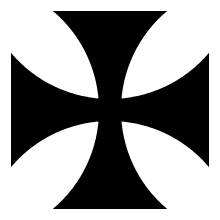Maltese cross
The Maltese cross, in Italy also known as the Amalfi cross, is the cross symbol associated with the Knights Hospitaller (the Knights of Malta) and by extension with the island of Malta. The cross is eight-pointed and has the form of four "V"-shaped elements, each joining the others at its vertex, leaving the other two tips spread outward symmetrically. Its design is based on crosses used since the First Crusade. It is also the modern symbol of Amalfi, a small Italian republic of the 11th century.
In the mid 16th century, when the Knights were at Malta, the familiar design now known as the "Maltese Cross" became associated with the island. The first evidence for Maltese Cross on Malta appears on the 2 Tarì and 4 Tarì Copper coins of the Grand Master Jean Parisot de Valette (Grand Master 1557–1568). The 2 and 4 Tarì Copper coins are dated 1567. This provides a date for the introduction of the Maltese Cross.[1]
The Maltese cross was depicted on the two mils coin in the old Maltese currency and is now shown on the back of the one and two Euro coins, introduced in January 2008.[2]


Symbolism
In the 15th century, the eight points of the four arms of the later called Maltese Cross represented the eight lands of origin, or Langues of the Knights Hospitaller: Auvergne, Provence, France, Aragon, Castille and Portugal, Italy, Baviere (Germany), and England (with Scotland and Ireland).[3]
The eight points also symbolize the eight obligations or aspirations of the knights:[3]
- to live in truth
- to have faith
- to repent one's sins
- to give proof of humility
- to love justice
- to be merciful
- to be sincere and wholehearted
- to endure persecution
Both the Order of Saint John (in German, the Johanniterorden) and the Venerable Order of St John teach that the eight points of the cross represent the eight Beatitudes. The Venerable Order's main service organisation, St John Ambulance, has applied secular meanings to the points as representing the traits of a good first aider:[4]
- Observant (“that he may note the causes and signs of injury”)
- Tactful (“that he may without thoughtless questions learn the symptoms and history of the case, and secure the confidence of the patients and bystanders”)
- Resourceful (“That he may use to the best advantage whatever is at hand to prevent further damage, and to assist Nature’s efforts to repair the mischief already done”)
- Dextrous (“that he may handle a patient without causing unnecessary pain, and use appliances efficiently and neatly”)
- Explicit (“that he may give clear instructions to the patient or the bystanders how best to assist him”)
- Discriminating (“that he may decide which of several injuries presses most for treatment by himself, what can best be left for the patient or bystanders to do, and what should be left for the medical men”)
- Persevering (“that he may continue his efforts, though not at first successful.”)
- Sympathetic (“that he may give real comfort and encouragement to the suffering”)
The Maltese cross remains the symbol of the Sovereign Military Order of Malta, of the Order of Saint John and its allied orders, of the Venerable Order of Saint John, and of their various service organisations. In recent centuries, numerous other orders have adopted the Maltese cross as part of their insignia (the Order of Saint Lazarus, for example, uses a green Maltese cross). In Australia, the Maltese Cross is part of the state emblem of Queensland.
Modern use
Aviation
The Maltese cross is used to identify the final approach fix in a non-precision instrument approach (one that lacks precision vertical guidance), in contrast to the use of a lightning bolt type icon, which identifies the final approach fix in a precision approach.
Australia
The flag, badge, and coat of arms of the state of Queensland feature a Maltese Cross and as such many public services incorporate the cross, including the Queensland police and ambulance services. The Maltese Cross is also part of the logo for various ambulance services in Australia, such as the South Australian Ambulance Service, the Queensland Ambulance Service, the Ambulance Service of New South Wales, Ambulance Victoria, St John Ambulance Northern Territory, St John Ambulance Western Australia, the Australian Capital Territory Ambulance Service. The Cross, known as the Fire Service Star, is also used by Country Fire Authority in Victoria as an official symbol. It can be seen on uniform hats and on Long Service and Outstanding Service Badges.
Austria
Austria's two highest decorations, the Decoration of Honour for Services to the Republic of Austria and the Austrian Decoration for Science and Art, have the Maltese Cross as their basis.
Belgium
In Belgium, the Maltese Cross is the basis of two of the country's royal orders of merit, the Order of Leopold and the Order of Leopold II.
Czech Republic
The 14th district of Prague has a Maltese cross on its coat of arms. The Maltese cross also appears on the coats of arms of several other Czech towns and villages, including Dobřichovice in Central Bohemia; Doubravice in South Bohemia; Staňkovice in the Ústí nad Labem Region; and Medlovice and Orlovice in South Moravia.
France
The Huguenot cross, a symbol of French Protestants, is a Maltese cross with a dove.
The football club AJ Auxerre, founded in 1905 by the priest Abbé Deschamps, has a Maltese cross as its emblem, adapted from that of the Catholic Association of French Youth.
Numerous French communes have the Maltese cross on their coats of arms. Among them are Drucourt, Eysines and Valcanville in Normandy; Rimbachzell in Alsace; Saint-Jean-de-Bassel in Lorraine; Rontalon in Aquitaine; Chappes in Auvergne; Arvieu in Aveyron; and Auton and Vinon-sur-Verdon in Provence.
Germany
The Johanniter-Unfall-Hilfe and the Malteser Hilfsdienst, the resp. Protestant and Catholic ambulance services in Germany, have a Maltese cross in their emblems. The coats of arms of the former duchy of Mecklenburg-Strelitz and the former Mecklenburg-Strelitz district contained a Maltese cross. Several towns in Northern Germany have a Maltese cross on their coats of arms, including Malchin, Mirow, Moraas, Rastow and Sülstorf. Heitersheim and Bad Dürrheim in Southern Germany also have a Maltese cross on their coats.

India
In India, the Maltese Cross is the symbol used by the Garhwal Rifles and Rajputana Rifles
Italy
In Italy, as stated earlier, it is also known as the "Amalfi cross". The Naval Jack of Italy is displaying the national coat of arms of four of the former Maritime republics with Amalfi at the lower left.

Malta
The Maltese cross is a national symbol of Malta and is displayed as part of the Maltese civil ensign. The Maltese euro coins of one and two euro denomination carry the Maltese cross. It is also the trademark of Air Malta, Malta's national airline.
Medicine
In medicine, the disease Babesiosis is recognized by the tetrad form that the parasite takes inside red blood cells. This is often referred to as a "maltese cross" sign because of the resemblance of the tetrad to the cross on peripheral blood smear.
Renal disease such as nephrotic syndrome produces a fatty cast composed of cholesterol that also has a "maltese cross" appearance on light microscopy.
Netherlands
In the Netherlands, the Maltese cross forms the basic form for the three highest royal orders of merit: the Orders of the Netherlands Lion, Orange-Nassau and the Gold Lion of the House of Nassau.
Two Dutch towns, Ermelo and Montfoort, use the Maltese cross on their flags, and the former on its coat of arms also.
Norway
In Norway, the Maltese Cross is the symbol used in the Order of St. Olav. Det Norske Veritas uses the Maltese Cross as symbol in the class notifications telling that the ship is constructed under their monitoring.
Philippines
In the Philippines, the Maltese cross is part of the school seal of Colegio de San Juan de Letran. It was founded by Don Juan Alonso Jeronimo Guerrero, a retired Spanish officer and one of the Knights of Malta and Fray Diego de Santa Maria, O.P., a Dominican brother. It is also a part of the pendant of the Quezon Service Cross, which is the highest honor that can be conferred in the Republic.[5]
Poland
In Poland, the Maltese Cross forms the base for the country's four highest awards of merit: the Order of the White Eagle, Virtuti Militari, the Order of Polonia Restituta and the Order of the Military Cross.
Portugal
In Portugal, the Maltese Cross forms the base for the country's Order of Merit.
Spain
In Spain, the Maltese Cross is the symbol used by the military Medical Corps. The cross also forms the basic form for some Spanish orders as the Order of Charles III or the Order of Isabella the Catholic. Several municipalities in Spain also use the Maltese cross on their flags and coats-of-arms, including Alguaire and Amposta in Catalonia, Lora del Río in Andalusia and O Páramo in Galicia.
Sweden
In Sweden a Maltese Cross forms the basic form for all the royal orders of merit, The Orders of the Seraphim, Sword, North Star and Vasa. Also the Maltese Cross is used by the Swedish Mounted Royal Guards as their coat of arms. The Swedish municipality of Mönsterås also uses a Maltese Cross on its arms.
Switzerland
The Maltese Cross is the Trademark of the oldest Swiss watch manufacturer, Vacheron Constantin. The coat of arms of Bardonnex, in the Canton of Geneva, also displays a Maltese cross.
United Kingdom

.svg.png)
- In the United Kingdom, the Maltese Cross is the symbol used by Rifle Regiments, and has been incorporated into the badges of virtually all rifle units, including the capbadge of the Bermuda Regiment, officers cross belt of the Gurkha Rifles[6] and now amalgamated, the Royal Green Jackets.
- The first postmark employed for the cancellation of the then new postage stamps in the 1840s was the shape of a Maltese cross and named accordingly.
- The Maltese cross also forms the basis for the design of the Order of the Bath and the Royal Victorian Order.
- The Maltese cross appears on the coat of arms of the London Borough of Hackney.
- The Maltese cross appears on the coat of arms of Saint John, one of the parishes of Jersey.
- The Maltese cross appears on the shirts of St Mark's FC (West Gorton)the forebears of Manchester City Football Club.
- The Maltese cross is the insignia of Methodist College Belfast and it appears on the blazers of the Sixth Form pupils as its crest.
- The Maltese cross is also the symbol of Neath Rugby Football Club.
- It is the symbol of the Royal Shrewsbury School Boat Club, displayed on the oars and uniform of the 1st VIII.
- It is a symbol used by the ATOC on rail tickets which allow travel on the London Underground between London Rail Terminals (e.g., between Euston and Victoria), when passengers are travelling via London. Alternatively, where the destination of the ticket is a London Travelcard Zone, the inclusion of the cross allows a passenger to undertake one single or return journey to any station within that Zone from the London Terminal station at which they arrived.
- It is used by the St John Ambulance organisation as their main form of identification.
- The Cross is also one of the symbols of Rosslyn Park FC, a rugby club in London, England.
United States
The Maltese cross with eagle, globe, and anchor in the center is used for the Sharpshooter badge in the United States Marine Corps.
Malta Boat Club, a sculling club on Philadelphia's Boat House Row, uses the Maltese cross as its logo.
Motorcycle clubs in the United States often include the cross pattée, or much less frequently the Maltese cross, in their insignia.
Phi Kappa Sigma, an international all-male college secret and social Fraternity, uses a Maltese cross as its symbol.
Items
The Maltese cross flower (Lychnis chalcedonica) is so named because its petals are similarly shaped, though its points are more rounded into "heart"-like shapes. The flower Tripterocalyx crux-maltae was also named for the Maltese cross.[7] The Geneva drive, a device that translates a continuous rotation into an intermittent rotary motion, is also sometimes called a "Maltese cross mechanism" after the shape of its main gear.
Similar crosses


Maltese crosses have been adapted for use in the cross of Saint Lazarus and as part of the flag of Wallis and Futuna. It has been the official badge (combined with an ellipsoid in the center) of the Delta Phi Fraternity since 1833. A similar cross is also used by the Veterans of Foreign Wars organization.
A variant of the Maltese cross, with three V-shaped arms instead of four, was used as the funnel symbol of the Hamburg Atlantic Line and their successors German Atlantic Line and Hanseatic Tours in 1958–1973 and 1991–1997. A five-armed variant is the "Cross" of the French Legion of Honour (Croix de la Légion d'honneur). A seven-armed variant known as the "Maltese asterisk", is used as the basis of Britain's Order of St Michael and St George.
Other crosses with spreading limbs are often mistakenly called "Maltese", especially the cross pattée. The official symbol of the Alpha Tau Omega fraternity is the cross pattée, though the organization's founder thought it was a Maltese cross when the organization was formed in 1865. The Nestorian cross also is very similar to both of these.
The cross of Saint Florian, patron saint of firefighters, is often confused with the Maltese cross (for example, the New York City Fire Department so calls it);[8] although it may have eight or more points, it also has large curved arcs between the points. The Philadelphia Fire Department, among others, incorporates the St. Florian cross into its insignia, as does the International Association of Fire Fighters.
The Maltese cross should not be mistaken for the George Cross, awarded to Malta by George VI of the United Kingdom in 1942, which is depicted, since 1964, on the national flag of Malta. The Maltese cross is depicted on the civil ensign of Malta, shown above.
See also
- Biker Cross
- Garhwal Rifles
- Iron Cross
- Order of Malta
- Order of Malta Ambulance Corps
- Pour le Mérite
- Red Cross stove
- Royal Green Jackets
References
- ↑ History of the Maltese Cross as used by the order of St. John of Jerusalem Accessed: 6/16/2012
- ↑ National Euro Changeover Committee - Euro Maltese Coins
- ↑ 3.0 3.1 "The Maltese Cross and its significance" GuidetoMalta.net, History. Accessed 17 July 2013.
- ↑ "The St. John Cross" (PDF). St. John Ambulance Service. Retrieved 2010-07-18.
- ↑ "The Quezon Service Cross". Retrieved 28 January 2013.
- ↑ Royal Gurkha Rifles build on Coldstream Guards’ success in southern Helmand Accessed: 6/16/2012
- ↑ CalFlora Botanical Names: T. crux-maltae
- ↑ History and Heritage / Origin of The Maltese Cross Accessed 17 July 2013.
External links
| Wikimedia Commons has media related to Maltese cross. |
- Sovereign Military Order of Malta - The Maltese Cross
- History of the Maltese cross
- History of the firefighters cross
- Maltese cross symbols in the Staten Island Historical Society Online Collections Database
- Simple method of sketching the cross neatly
- The Maltese Cross: A Cherished Symbol
- The St John Ambulance